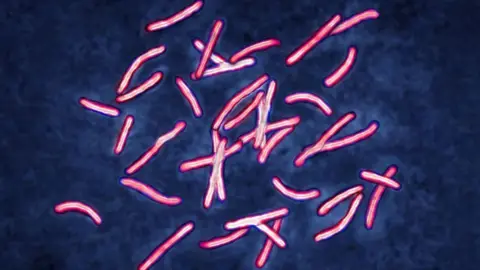Expertise reporter
 Getty Pictures
Getty PicturesA posh drawback that took microbiologists a decade to resolve has been solved in simply two days by a brand new synthetic intelligence (AI) software.
Professor José R Penadés and his group at Imperial School London had spent years understanding and proving why some superbugs are proof against antibiotics.
He gave “co-scientist” – a software made by Google – a brief immediate asking it concerning the core drawback he had been investigating and it reached the identical conclusion in 48 hours.
He advised the BBC of his shock when he discovered what it had carried out, given his analysis was not printed so couldn’t have been discovered by the AI system within the public area.
“I used to be procuring with any individual, I stated, ‘please go away me alone for an hour, I must digest this factor,'” he advised the In the present day programme, on BBC Radio 4.
“I wrote an e mail to Google to say, ‘you may have entry to my laptop, is that proper?'”, he added.
The tech big confirmed it had not.
The complete decade spent by the scientists additionally consists of the time it took to show the analysis, which itself was a number of years.
However they are saying, had they’d the speculation firstly of the undertaking, it might have saved years of labor.
Prof Penadés’ stated the software had in reality carried out greater than efficiently replicating his analysis.
“It is not simply that the highest speculation they supply was the suitable one,” he stated.
“It is that they supply one other 4, and all of them made sense.
“And for considered one of them, we by no means considered it, and we’re now engaged on that.”
Bugged by superbugs
The researchers have been making an attempt looking for out how some superbugs – harmful germs which can be immune to antibiotics – get created.
Their speculation is that the superbugs can type a tail from completely different viruses which permits them to unfold between species.
Prof Penadés likened it to the superbugs having “keys” which enabled them to maneuver from dwelling to dwelling, or host species to host species.
Critically, this speculation was distinctive to the analysis group and had not been printed anyplace else. No person within the group had shared their findings.
So Mr Penadés was completely happy to make use of this to check Google’s new AI software.
Simply two days later, the AI returned a number of hypotheses – and its first thought, the highest reply supplied, steered superbugs might take tails in precisely the way in which his analysis described.
‘It will change science’
The affect of AI is hotly contested.
Its advocates say it should enable scientific advances – whereas others fear it should eliminate jobs.
Prof Penadés stated he understood why fears concerning the affect on jobs comparable to his was the “first response” individuals had however added “when you consider it it is extra that you’ve a particularly highly effective software.”
He stated the researchers on the undertaking have been satisfied that it might show very helpful sooner or later.
“I really feel this may change science, undoubtedly,” Mr Penadés stated.
“I am in entrance of one thing that’s spectacular, and I am very completely happy to be a part of that.
“It is like you may have the chance to be enjoying a giant match – I really feel like I am lastly enjoying a Champions League match with this factor.”


